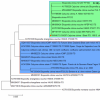
24-12-2025 17:08
Hulda Caroline HolteHello, I have found this propoloid ascomycete on

21-12-2025 09:32
Hello.A tiny ascomycete found embedded in wood in

21-12-2025 21:32
Pol DebaenstHello, Garden, Burgweg 19, Veurne, BelgiumOn 10/1

22-12-2025 23:38
Patrice TANCHAUDBonsoir, récolte sur un mur en pierre, apothéci

22-12-2025 00:47
Patrice TANCHAUDBonsoir, récolte à proximité du milieu dunaire
Calycina citrina vs. confluens, ecology
Viktorie Halasu,
15-11-2021 23:56
 Hello forum,
Hello forum,I would like to ask, what is your experience with the ecology of Calycina citrina vs. C. confluens? Do they have any biotop / substrate / wood size preference? I have here a small riparian forest I visit frequently (ash, oak, elm, poplar...) and for several years I keep finding only C. confluens there. So I wonder why not also C. citrina, which is supposed to be at least just as common. Does it prefer bulky beech wood?
Thank you.
Viktorie
Hans-Otto Baral,
16-11-2021 10:50

Re : Calycina citrina vs. confluens, ecology
I have as substrate often Corylus, also often Alnus, rarely Salix, Fagus and Fraxinus. C. citrina is very often on Fagus, also often on Carpinus, but Alnus, Ulmus, Quercus and even conifers occur. Whether riparian forests are preferred by confluens I cannot easily say. But I must admit that the separation of the two species is difficult. Genetically they are different, according to the few available sequences of confluens.
Viktorie Halasu,
16-11-2021 11:04

Re : Calycina citrina vs. confluens, ecology
Ok, there was a nice rich population on Ulmus branch, I'll do a better micro and separate a piece for sequencing. Free spores 0-1septate, (12,7)14.3-16.7(17.5) x (4)4.5-5(5.5) um, asci H+ IKI+b.
Another older collection on Tilia had smaller spores, (10.8)11.9-14.8(15.2) x (3.7) 4.2-4.7(5.1), 0-1septate (free spores). I'm not sure whether to call it confluens too, at that time I forgot to check the septation inside living asci. If I remember correctly, you wrote in another thread something about C. citrina never having spores more than 1s, but confluens 1-3s - did you mean inside asci or free (possibly overmature) spores?
Another older collection on Tilia had smaller spores, (10.8)11.9-14.8(15.2) x (3.7) 4.2-4.7(5.1), 0-1septate (free spores). I'm not sure whether to call it confluens too, at that time I forgot to check the septation inside living asci. If I remember correctly, you wrote in another thread something about C. citrina never having spores more than 1s, but confluens 1-3s - did you mean inside asci or free (possibly overmature) spores?
Hans-Otto Baral,
16-11-2021 11:33

Re : Calycina citrina vs. confluens, ecology
Septate spores can be both inside and outside the asci, but NEVER inside living asci in this species complex. Overmature spores could help: 1-septate = citrina, 1-3-septate = confluens.
The genetic situation is unclear (March 2021). There are two distinct clades, but which is which?
For Guy's collection and Florian Prell's FP100 docus are available to me. Spore size is similar. Guy uploaded his sequence, it got the number KY462815.
